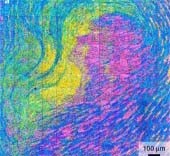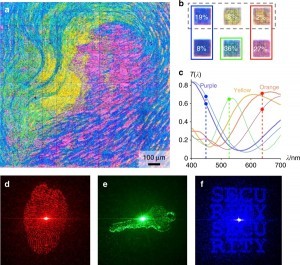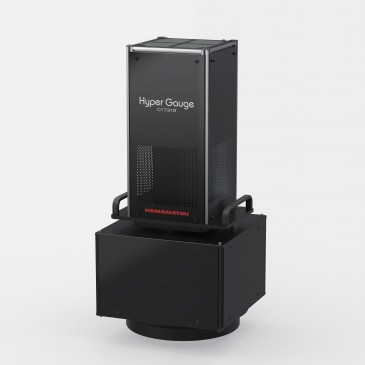
Researchers from the Singapore University of Technology and Design (SUTD) have invented a new type of optical anti-counterfeiting device they call holographic color prints.
"The holographic color print consists of materials that are transparent to light, but due to the unique way that the material is patterned on the nanoscale, it appears as a colorful printed image when illuminated by white light through the film, similar to a color-printed transparency," says Associate Professor Joel Yang, who led the research. The "holographic" aspect of the color print provides its ability to encode up to three separate holographic projections when illuminated using laser light of different colors.
Furthermore, the professor explains, such holographic devices (i.e., diffractive optical elements) currently do not have a colorful appearance, let alone appear as a colorful image. They appear as a whitish patch similar to frosted glass, and, conversely, color prints do not have a dual function as a hologram. "The uniqueness of this technology is in its ability to have this dual functionality in a single print," Yang says, adding, "As the colors arise due to redirection and not absorption of the light, one could consider using them also in applications where optical losses due to absorption is to be minimized."
Advantages of optical anti-counterfeiting device
"A security device that is hidden in plain sight as a color print adds aesthetic value and enhanced security compared with microprints or holograms alone," the expert says about his invention’s edge over previous approaches. "The ability to 3D-print them together using the methods we developed allows customizability of both the print and the holographic projections."
Enabling the next generation of anti-counterfeiting applications
Yang agrees that the concepts introduced by his team could be applied to enable "interesting optical effects" that leverage both color and phase control of light.
Speaking more generally on the potential impact of his research breakthrough on the future of optical nanotechnologies, the professor elaborates that the rapid progress in nanofabrication capabilities in 3D has allowed the introduction of color into otherwise colorless materials and devices by nanostructuring these materials. "I believe this new capability will play an important role in the way researchers and engineers design new optical devices in future," Yang projects.
Hurdles in developing the holographic color prints
Both the fabrication and design of the individual element of the holographic color prints were challenging, according to Yang.

"The effort spearheaded by Kevin Lim, a talented researcher in my group, enabled tweaks in the code to help with the fabrication and tweaks in the fabrication that more closely matched what we wanted to achieve in the code." He says this iterative process took many months and resulted in the high quality prints the team reported in the paper “Holographic colour prints for enhanced optical security by combined phase and amplitude control,” recently published in Nature Communications.
Next steps
Yang says he and his colleagues plan to continue improving the visual appearance of the holographic projection and to work towards commercialization of this technology.
Written by Sandra Henderson, Research Editor, Novus Light Technologies Today























 Back to Features
Back to Features

























